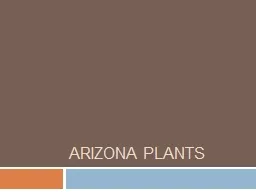PPT-Arizona Plants
Author : liane-varnes | Published Date : 2016-05-26
Mesquite Trees There are three main types in AZ Screwbean Honey Velvet Mesquites have taproots that go deep into the ground to find water Mesquite Trees They are
Presentation Embed Code
Download Presentation
Download Presentation The PPT/PDF document "Arizona Plants" is the property of its rightful owner. Permission is granted to download and print the materials on this website for personal, non-commercial use only, and to display it on your personal computer provided you do not modify the materials and that you retain all copyright notices contained in the materials. By downloading content from our website, you accept the terms of this agreement.
Arizona Plants: Transcript
Download Rules Of Document
"Arizona Plants"The content belongs to its owner. You may download and print it for personal use, without modification, and keep all copyright notices. By downloading, you agree to these terms.
Related Documents














